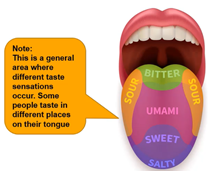This week in our Coffee University journey, we’re diving into the essential art of coffee tasting. This information is tailored for you, our frontline conveyors of knowledge to customers.

Understanding your taste buds
To navigate the diverse world of coffee flavors, one must first know their taste buds. The sensory experience of coffee involves recognizing taste sensations – bitter, sour, salty, sweet and umami, which is a rich or savory flavor resulting from several amino acid or nucleotides.
Trying coffee with two distinct methods
- Cupping: A method employed by sensory experts for grading and profiling purposes, cupping involves evaluating coffee without considering brewing equipment or throw weight.
- Tasting: This is the typical customer experience. It involves using the same brewing fundamentals and equipment as foodservice operators and assessing the coffee based on the customer feedback.
Completing a tasting demo with a customer
- Look: Assess the shade of the coffee, indicating the roast’s darkness and throw weight. Note the presence of oils, which reflect the roast’s intensity or potential uncleanliness in equipment.
- Smell: Acknowledge the emotional side of coffee-drinking. The aroma contributes to the overall enjoyment and can be a teaser to the brain.
- Taste: Encourage customers to taste with their preferred sweeteners or creamers. Ensure the coffee is served above 160 degrees Fahrenheit, preserving its attributes. Highlight two critical attributes for customers to focus on body (heaviness on the tongue) and acidity (the “snap” on the roof of the mouth). Make sure customers “slurp” the coffee to cover all taste bud and activate olfactory glands.
- Evaluate: Guide customers through a structured tasting process. Begin with a coffee matching their current profile, followed by the recommended coffee. Finally, let them taste their current coffee, emphasizing the stark differences. Limit the tasting to three to four coffees to avoid confusion and always make sure to have a decaf on hand.
To provide a comprehensive coffee experience, ensure customers are versed in the four steps in tasting, as well as the seven steps to excellent brewed coffee, which was covered in Coffee University: Brewing Basics.
Teaching customers cup quality checks
Empower your customers to maintain coffee excellence with:
- Water quality: Emphasize the importance of filtration and brew time.
- Coffee freshness: Remind customers to store coffee away from air and moisture.
- Brew temperature: Educate on the impact of temperature on extraction.
- Cleanliness: Advise against using soap or bleach on surfaces in contact with coffee.
Whether you are meeting with customers in the field, fixing customer equipment or working with customers virtually, it is vital we use this information to offer the best coffee experience possible. Educating customers on our coffee and best practices will always make us stand out for both our knowledge and customer service.
